American Sabbatical 96: 4/17/97
Vicksburg
4/17.. Vicksburg.
Kosciusko Thursday was a laundry morning. While Peggy communed with Homer, I played
patience with quarters in the local suds-o-rama. A skinhead with
toos glared at me the while, but I figured that was his natural
grimace, so I tipped him a nod, and kept rolling my eyeballs.
A hairball in Miami costume is just as sharp as any guy in U-shirt
and chains.
Then we ducked back onto the Trace for more heal-all. This section
of the National Parkway is shouldered with blackeyed susans and
what looks like baby’s-breath along with masses of crimson clover
and carpets of the pale lavender heal-all. And the road unrolls
like a dream.
We were skirting the Yockandokany river, and where it has been
dammed to form the Burnett Reservoir we pulled into a picnic area.
A romantic prospect of drowned islands with old cypress spiking
up, and sleepy trollers in john boats. I traded lies with a ranger
who had just seen “30 or 40” turkeys in the piney woods, and his
eyes were still shining. He had tales of wild pig, too, and said
the armadillos were commonplace. We’ve also seen roadkill coyote.
We kept jawing slowly in an easy country way, about logging and
wildcats, gators and turtles. I could just conjure his Mississippian,
and he probably felt the same. We could have parled on indefinitely,
but Peggy was pacing up and down, so we smiled at the impatience
of women, and the Owlers moved on.
Not far, though. There was a swamp walk just down the Trace and Peggy was so apologetic about hurrying the menfolk that we back-winged and lit. The Boy Scouts had graveled a circle stroll around a slough, and bridged back across it to the lot. Our ramble brought us into a sunny opening where we saw a good sized gator sunning himself in the shallows. Back into the moody woods we hunted for a likely spot to draw a swampscape. This was a tupelo swamp, with only the odd cypress, and the ovate leaves were just broadening, so everything was dappled with shadows. A bright yellow-green algae covered the entire water surface around the swollen bases of the trees except for narrow channels of absolute black water. Bushy 4 inch evergreen clubs rose out of the level fabric, and cypress knees stood here and there like unfinished statuettes. Purple spiderworts starred out from their grassy stems at our feet, and great sprays of cardinal flowers edged the banks in places.

Bryce's Swamp
(with skink)
We broke out our colors on the foot bridge, and attempted the impossible. Into our meditations an iridescent blue-tailed skink investigated. All six inches of him. His slender tapered tail ran from an electric blue at the tip up to a deep violet at his midsection, then he was black and yellow striped to his nose, with yellow bulging eyes. First he clambered over my foot. Then, while I was busy trying to make bark crusty, he must have climbed my leg, because he suddenly appeared on the rail beside my knee. He lay down on the top of the bridge rail, warming his belly, and folded all four legs on his back. A shiny glowing clown. Honored, I’m sure, Mr. Skink.
Our haste had evaporated. So had our through way. The Trace was
closed for repairs north of Jackson, and probably just as well,
because we opted to make a wide sweep around the state capitol,
and find our way through Flora to Vicksburg. The sideroads proved
almost as easy to take as the groomed Parkway. Rural crossroad
settlements just 15 miles from the bureaucratic middle, cattle
and timber with cotton just starting in the flatlands as we came
closer to the big river again.
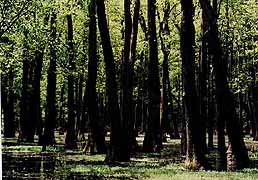
By cameral
The State of Mississippi may stint its school budgets, but it
prides itself on its hospitality. The first ten miles of the 28
major roads entering the state have been planted with magnolia
trees. 35,000 magnolias have been donated by such organizations
as the Garden Clubs of Mississippi, Inc. And the state DOT has
wildflower test plots where they try out mass planting of ox-eyed
daises and the like, and apply the lessons to the state roads.
We were welcomed with flowers all the way from Flora to the river.
At Vicksburg. It was too late to jump right into the trenches
and redoubts, redans and lunettes, this afternoon. We settled
on an early supper at a local bistro recommended by the tourist
info office, where we’d scooped the local handouts. Peggy can
vacuum up an armload of brochures in a motel lobby, restaurant,
or tourist office in a blink. Don’t leave any loose papers around
when she blows into your town.
The Walnut Hills proved to be yet another Southern fried delectorium.
We did the four vegetables again, this time with okra and egg
plant in the mix. I also had a cup of shrimp gumbo, just to dance
on the edge. Southern cooking is sure good tasting, but it’s not
exactly the diabetic’s ideal. Everything is saturated in either
fats or sugar, or both. The okra was deep fried in breaded balls,
and the eggplant was sauteed with bacon and then sugared. The
carrots were CANDIED. I laughed when dessert was mentioned.
We waddled back to the bird and motored around this fortress town, trying to get a feel for the geographics. The Yazoo joins the Mississippi here and the high bluffs of Vicksburg make a wall along the east bank of the tributary to their junction, then the big river bends away west, edging the heights. The present day town is a sad looking place. Some grand old edifices.. private homes and commercial blocks.. stand forlorn in a sea of shabby. The old waterfront boasts 2 mock-steamboat casinos, Harrah’s and the Steamboat Casino, and some industrial terminals. Up the Yazoo (same to you fella) there’s a barge terminal, with empty barges jumbled whichaway in the marshes, and the backwaters are lined with a series of processing factories, bellowing smoke and nauseous aromas. Scenes from a watery Purgatorio.
The big bridge to Louisiana comes off the heights below the Yazoo outlet. A twin double-cantilevered truss affair tying Mizsippi and Looiezana together. Nobody seems interested. The restaurants on the bluffs look on the road while all that grand engineering is just a hohum out back. We stopped in a motel lot to watch the sun simmering over Louisianna and towboats pushing rafts of barges against the seething flow.
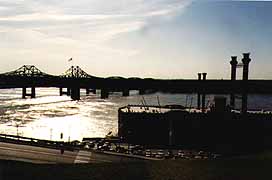
Sunset Casino
We went with the flow to our encampment in the Indian subcontinent.
Someone could do a thesis on how the East Indians are cornering
the motel trade.
4/18 .. Armed engagements.
Our sleep shack backed on the National Battlefield Monument, so we tumbled to
our feet at reveille, and trooped into the war zone. This one
is very strange, to a contemporary eye. Because the battle and
the siege lasted for months, without particularly memorable clashes..
except to the thousands who died here.. the 16 mile long park
encircling Vicksburg doesn’t have hallowed perspectives. Unlike
Gettysburg with the scene of Pickett’s Charge or the Little Round
Top.. or the Sunken Road and the Peach Orchard at Shiloh.
You drive across incredibly broken ground, deep declivities, looming
embankments. And the way is lined with monuments. Hundreds of
them. A processional way of 19th century military sculpture. With
a startling wrinkle. There are gigantic busts and granite relief
portraits of every senior officer who was here. Union and Confed.
Very Romanesque, and either comical or unsettling, we weren’t
sure which. Where the mega-busts were lined up in rows paralleling
the drive, it was like the corridors of deities in the Ringling
Museum courtyard, or at the Getty.. only the villa backdrop was
towering hardwoods. The battle sites must have been stripped bare,
of course, to build the massive fortifications and to feed the
watchfires of a hundred circling camps.
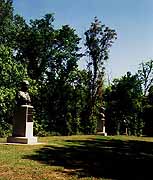
Getting Busted
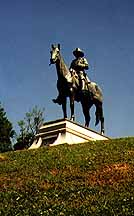
Man on Horseback
The largest officer statue is of Grant, astride his charger, and
he rides the top of a high ridge at his command post, looking
down on all comers. Sam Grant has been systematically maligned
by history. As a drunk, a slob, the dupe (or crony) of unscrupulous
manipulators during his presidency. The fact that he was the best
general of the war, who out-generaled that romantic paragon, Lee,
is generally overlooked. Mark Twain accused Sir Walter Scott of
causing the Civil War. The Southern aristocracy, he said, had
been weaned on Scott’s chivalric idealism, and couldn’t get it
through their heads that knights in armor were as dead as.. well..
J.E.B. Stuart. Grant’s unforgivable flaw was that he was a totally
modern warrior. Valuing strategy over heroics, logistics over
idealism.. and he was utterly ruthless in pursuing victory to
the end. Not Sir Walter’s ideal of a hero.
More than chivalry died on the fields of Shiloh and Vicksburg
and the rest. Being confronted with the lists of names here is
just as sobering as those lists on black marble on the Washington
Mall. All the Gileses and Jedediahs and Zachariahs. And at the
Wisconsin memorial I was struck that these had all been farm boys.
The whole war was fought by a rural people, self-destructing in
the face of a new industrial destiny. Those Wisconsin boys probably
had more in common with Johnny Reb than he did with the industrial
wage-earner who was replacing them both.
Well, the trees have retaken these battlefields, and we have forgotten
that only a short while ago we tore ourselves apart so a new paradigm
could bury the dream of an agrarian democracy. And Sir Walter
was unhorsed.
(Memo #92)
Apr 18 Vicksburg
Who? Gen.U.S. Grant (USA) v. Gen. J.E. Johnston + Lt. Gen. J.
Pemberton (CSA)
What? siege and battles
When? 1863
Where? Vicksburg, Mississippi, key town on Mississippi River
How? battles + bombardments + siege of a civilian population
Topics: Vicksburg, Civil War, military strategy, Mississippi River,
siege warfare
Questions: Why was Vicksburg so important? How difficult was the
siege for the civilians?
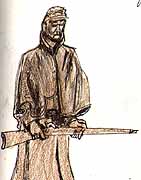
Vicksburg played a critical role in the Civil War. Sited high
on bluffs overlooking a bend in the Mississippi River, the city
controlled shipping and was crucial to victory for the North and
South. For the North, seizing Vicksburg would split the Confederacy
and halt its export of cotton. It would also enable Union farmers
in the Midwest to ship their grain out (the original reason we
wanted the river and bought the whole Louisiana Purchase in 1803).
The South had to hold Vicksburg to guarantee its cotton exports.
Both sides knew how important the city was; Lincoln called it
the key to winning the war. The fight for Vicksburg was long and
involved, a “campaign” that included a number of battles and bombardments
and a siege.
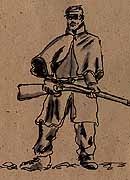
Rifleman
The South fortified the town with many units of the army and gun
emplacements overlooking the river. In the first action in the
Mississippi valley, the Union first sent an army under U.S. Grant
south up the Tennessee and Cumberland Rivers. In 1862 it captured
Forts Henry and Donelson and was pummeled at Shiloh. A second
Union force started from the mouth of the Mississippi fighting
its way north. Grant’s army slogged South along the western side
of the Mississippi toward Vicksburg, “slogged” literally through
low, wet, marshy land. Union gunboat forces from the north kept
trying to get by Vicksburg and failing - the barrage from the
fortifications was too intense - until April 1863 when a gunboat
force made it. This force helped Grant move his men across the
Mississippi below Vicksburg at Bruinsburg (itself one of the “largest
amphibious operations in American military history”). 24,000 men
and 60 cannons were ferried across (April 30 - May 1, 1863).
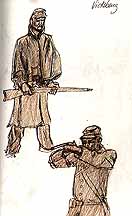
Peggy's Statues

Wisconsin Memorial
Grant then moved east to sweep around Vicksburg, cut the railroad
to isolate it , and come at it from inland. There was a Battle
of Port Gibson, a Battle of Raymond, a Battle of Jackson (which
gave the Union control of the Mississippi state capital), a Battle
of Champion Hill, a Battle of Big Bend River Bridge. On May 19
Grant made his first attack on “Fortress Vicksburg” from the east
which failed. A second attack on May 22nd also failed. This is
when Grant instituted a siege.
The siege of Vicksburg endured from May 19 - July 4. The South
was unable to get reinforcements through to the city from eastern
Mississippi. Vicksburg was under constant bombardment from two
directions (Union gunboats on the Mississippi and the Union army
to the east). Grant constructed “approaches” to the city and tunnels
to use for explosives to destroy the Confederate fortifications.
On June 25 a Union explosion and attack failed.
During the siege, Vicksburg civilians dug caves and took refuge in their cellars as well. There was rationing, sickness, battle casualties in the city. I had heard stories of people being reduced to eating rats and grass.
There is a diary by a Vicksburg woman, Emma Balfour, which vividly
describes the siege day by day (and her own sangfroid).
“Saturday May 30 - We has comparative quiet yesterday after the
morning till five o’clock when the most fearful cannonading commenced
from the lines. I never saw anything like it. People were running
in every direction to find a place of safety. The shells fell
LITERALLY like hail. Mrs. Willis’ house was struck twice and two
horses in front of her door were killed. Gen. Pemburton and his
staff had to quit it. I made the servants crouch under the alley
wall and all the couriers got under there with them. I took my
knitting and went into the parlor as I did not think the shells
would do me much harm by the time they passed through three brick
walls...”
The Confederates surrendered on July 4th (the same day victory
was won at Gettysburg, two battles that turned the tide for the
Union impressing the superstitious by occurring on Independence
Day). Interestingly Grant did not hold out for an unconditional
surrender (his trademark which is what his initials are said to
stand for). but accepted parole to the defenders.
One of the main objectives of our travels is to feel and experience
the geography of historical events. Many terms are inexact and
need clarification. What exactly does a “rise” mean, or a “gap”,
or “bluffs”? It makes a huge difference to the people who fought
or engineered or explored there if it is twenty feet high or a
hundred feet high, if it is a gradual slope or vertical. The “ridge”
at Gettysburg felt like a “rise” to me. The “mounds” at Ocmulgee
and Etowah felt like huge earthen “pyramids”. What about the geography
at Vicksburg?
The “bluffs” at Vicksburg on the river side are high and fairly
steep, but don’t quite feel like “cliffs” since they are not of
stone. This drop off on the river side is climbable and turf covered.
Interesting that the strategy in the Civil War did not include
scaling these riverside bluffs (Union soldiers scaled the far
more imposing “cliffs” at Lookout Mountain). Why not? Was it impossible
to land troops under the cliffs given the stiff resistance and
artillery on top?
Perhaps the neatest part of Vicksburg is the resurrected ironclad
gunboat (the USS Cairo) which is in dry dock at the battlefield.
It’s apparently the first boat sunk by a “torpedo” (a suspended
five gallon jug full of black powder that was detonated from shore).
The boat was raised from the river bed, cleaned and has been reassembled
as much as possible. It’s housed outdoors under a huge metal shed.
The boat is mostly a framework with some cannons in place and
some of the iron plate superstructure. You can see the ribs and
decks, the boilers and wheel. It’s huge (175 feet long, 51 feet
wide) and massive (512 tons, 75 tons of plate armor). It carried
13 guns. Some of the iron plating was plate, but the bow was sheathed
with lengths of railroad ties!! Yet it only had a draft of six
feet. Its engines were fueled by 18-20 bushels of coal an hour
(which required the work of 4 “coal heavers” in the crew). There
were 175 men on her (somehow the history books don’t really feature
the thousands on men on ships during the Civil War, especially
on the highly effective Union blockade).
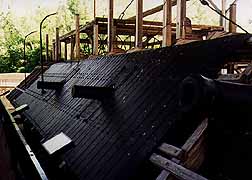
Bow guns and plating
The ironclads were part of General Winfield Scott’s “anaconda plan” to strangle the Confederacy by cutting off its trade. The Cairo was designed by James Eads who got more fame for his later bridge designs.
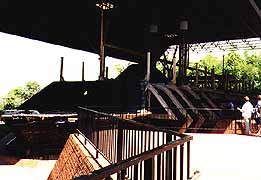
Ironclad
The museum (a building shaped like an ironclad) has a display
of items retrieved along with the boat - equipment and personal
things from fencing foil to pistols, tableware to doctor’s supplies,
pencils and erasers, sewing kits, razors, shoes, silk neckerchief.
Even army issue spittoons! All had been pretty well preserved
under water. The displays made the men of the gunboat much more
real!
I got a good sense of the land. It seems like impossible land to fight through on foot, very complex topography with ridges and gullies going every which way. In fact the North never did launch a full attack on the steep hills and deep gullies held by the Confederates at Vicksburg. Grant was realistic in choosing a siege over a general assault.
4/18.. cont.
Our friend Steve Stern had been stationed at the Army Waterways Experiment Station in
Vicksburg when he was in the Army Corps of Engineers, and had
described some of the modeling and testing going on there. We
wanted to see what we could. River drainage models. Fanciful vehicles.
Environmental recovery experiments. So we took the hike to WES,
Vicksburg, and checked in at the info office.
Turns out that only a handful of demos are open to the public, and we weren’t willing to hustle our way past the guard, because we didn’t really know what we might see. So we did the self-tour. Saw the Niagara Falls model in action, and a relief map of the Mississippi drainage basin. Very discomfiting, that. Looked like a high school project, and someone had redirected the Tennessee into the Alabama so it drained into the Gulf at Mobile. Probably a football joke. But these guys are in charge of managing our waterways?
The experimental vehicles display was a grassy lot where a semi-circle
of tanks and the like were sinking into the turf. One of my favorite
vehicles was here in the alloy, a swamp crawler. I’d seen pictures
of it from the 1950s in that seminal sourcebook for toymakers:
The How and Why of Mechanical Movements. It’s a tinboat perched on two rotating pontoons which have Archimedes
screws (helical fins) welded around them. The whole shooting match
screws its way across the mud or swamp. Probably rips up the environment
wicked, but ain’t that the ultimate clammer wagon? Just imagine
one jet-ski size. I can hear it oozing by now.
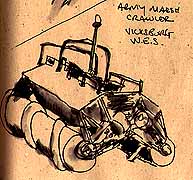
Mud Crawler
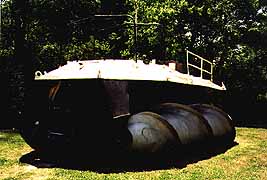
In camera
Pretty sorry show, Uncle. Compared with the heavy equipment lots
we see on the backroads, there’s no question who has all the toys
in this country. The private sector. I guess that’s a relief.
We were relieved to slip out of Vicksburg by a back street, and
we navigated by compass back toward the Trace. A couple of miles
from WES and the state roads were as idyllic as the Parkway itself,
wildflowers and all. Rising into undulations, shade-tree dotted
pastures. We fly into a flock of long-legged short-necked birds
that had been foraging among the cattle. Snowy bitterns? Just
about the time we started to second-guess our dead reckoning,
we bumped into the Trace. Our last lap on the sylvan expressway,
and we were torn. Carry on to Natchez for a grand finale, and
visit the Grand Village of the Natchez, where DeSoto wintered
and recorded most of what we know historically of the Mississippian
people? Or boogie down toward New Orleans?
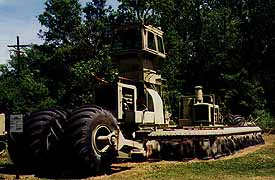
Hovertruck
Our texts indicated there wasn’t much to see at the Grand Village,
and we had reservations in the Quarter for tomorrow night. By
cutting the corner we would get an extra day in the Big Easy.
So we parted ways with the Natchez Trace around Fayette and dodged
crosslots for the Homochitto National Forest near the southwest
corner of Mississippi.
I take back everything I’ve said about enlightened highway planning
in Mississippi. From Fayette to McComb they are ravishing the
roadsides fit to make you gag. All the big line trees are gone,
and everything else back thirty yards. But all they took were
the big sticks. All the slash, big limbs and all, are still scattered
along the ways. Sometimes there’s a smoldering pile, or the charred
wreckage of one. It’s heartbreakingly ugly. I suppose it will
all be wildflowers on day. Right now the grinning logtrucks keep
coming at you like a train, piled high with dollars, if not good
sense. The rape zone didn’t even quit when it hit the National
Forest. There were a few elisions where you were back in the woods
briefly, but whoever manipulated this boondoggle didn’t much care
who had riparian rights. It was almost a relief to hit the mall
strip of McComb.
We filled the larder with comestibles, and snuck off into the
Percy Quinn State Park. Here at least the State of Mississippi
has kept up her reputation for hospitality. Too much so, maybe.
There was a long line of pickups and camper-trailers with Louisiana
plates emitting at the gate. No sites available, the sign said.
But we got waved through and directed to primitive camping, they
had our number.
Friday night in the boonies, only 80 miles out from New Orleans,
and it was a family scene.. going wild. Smoky campfires. Struggling
with tentpoles. Lugging in tons of vital supplies and equipment.
Untangling the dogs. Tired kids. Did you forget the...? Big Coleman
lanterns to chase away the dark. Radios to scare off the silence.
Don’t you love weekend camping?
Peggy and I wandered in the woods by the lake. Let it seep out
some. Left Homer sleeping in his pack. Admired the waxing moon.
Lay down on the ground.